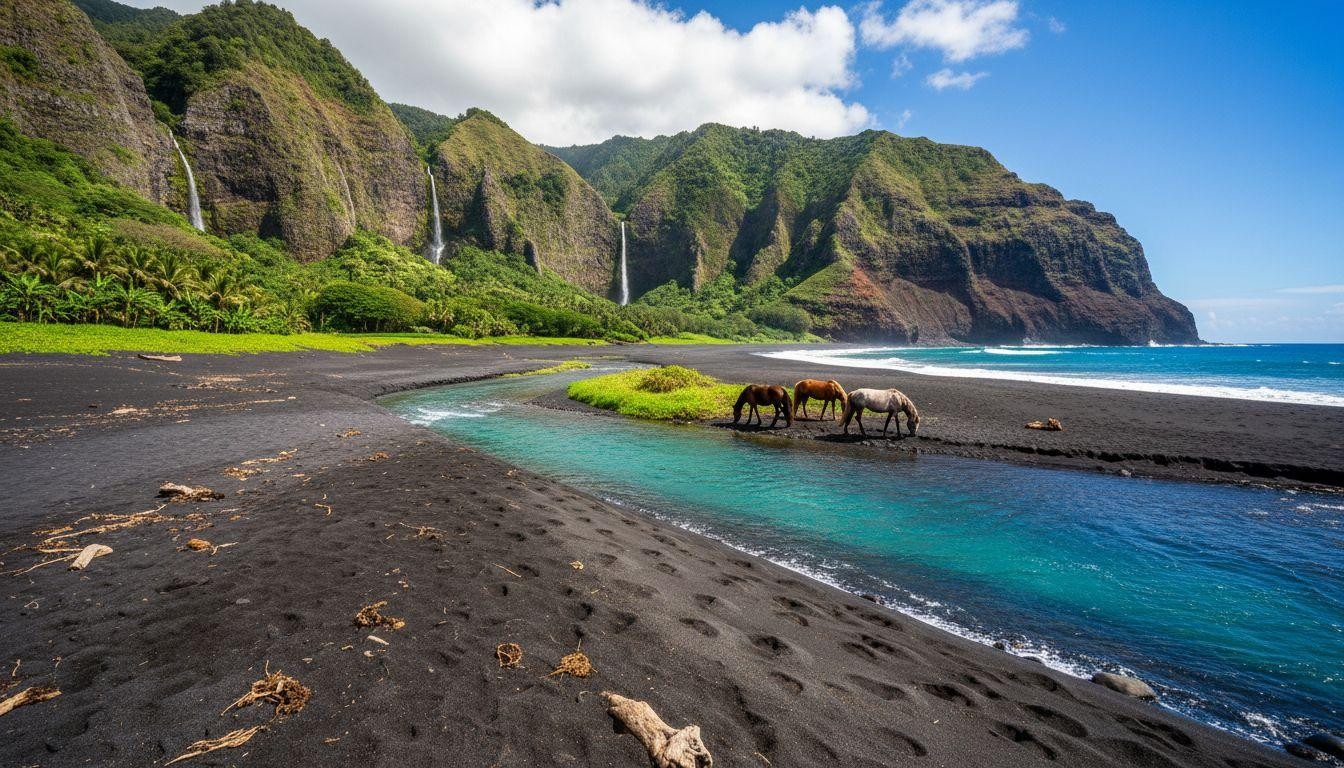Black volcanic sand meets turquoise water in Hawaii’s Waipio Valley, where a freshwater stream divides the beach and wild horses graze along ancient cliffs. This remote Big Island sanctuary offers something no other Hawaiian beach can: a mile-long stretch of jet-black sand accessible only by hiking down America’s steepest road or taking a grueling 1,000-foot descent on foot.
The reward justifies every challenging step. Where most black sand beaches feel harsh and unwelcoming, Waipio’s unique geography creates surprisingly calm swimming conditions in the stream mouth area.
Descending into Hawaii’s sacred valley
The journey begins at Waipio Valley Lookout, perched 1,000 feet above the Pacific Ocean. From this vantage point, the valley floor spreads below like a green carpet dotted with traditional taro farms and the silver ribbon of Wailoa Stream.
The road down maintains an average 25% grade, reaching 45% in some sections. Most rental car companies prohibit driving this route due to liability concerns, making 4WD tours the practical choice for most visitors.
Guided tours from nearby Honokaa cost $120-180 per person for half-day adventures. The alternative requires hiking 1.3 miles down a steep trail that takes 45-60 minutes each direction. Valley floor access restrictions implemented in November 2024 make tours increasingly valuable.
Where stream meets ocean on volcanic sand
Waipio Valley Beach stretches for one mile along the northeastern coast, its black sand formed from centuries of volcanic activity and ocean erosion. The Wailoa Stream bisects the beach, creating two distinct swimming environments.
The stream division phenomenon
Fresh mountain water flows year-round through the valley, meeting salt water in a brackish mixing zone. During dry months (May-September), the stream averages 2-3 feet deep and remains crossable on foot.
Winter rains can swell the stream to 6-8 feet, making crossing dangerous or impossible. Flash flood warnings are common November through March, when the valley receives up to 15 inches of monthly rainfall.
Wild horses roam the shoreline
Approximately 50 wild horses descended from 19th-century ranch stock call Waipio Valley home. These animals move freely between pastures and beach, often grazing near the stream mouth at dawn and dusk.
Horse sightings have decreased since road access restrictions began. A local valley guide noted seeing only 3-5 horses daily compared to 15-20 in previous years. The animals are becoming increasingly wild and should never be approached or fed.
Swimming in volcanic sanctuary waters
Unlike many Big Island black sand beaches with dangerous surf, Waipio offers relatively protected swimming zones. The valley’s horseshoe shape provides natural wind protection, while the stream mouth creates a semi-enclosed lagoon area.
Safe zones and hazardous areas
The calmest swimming occurs where the stream meets the ocean, creating a natural pool during low tide. Water temperatures average 77°F in November, several degrees warmer than exposed ocean areas.
Strong rip currents exist on both sides of the stream mouth. Hazards include submerged rocks, undertow, and occasional shark sightings in deeper water. No lifeguards patrol this remote location, making swimming a risk-managed activity.
Valley floor hiking and photography
Beyond the beach, trails wind through active taro farms and lead to Hi’ilawe Falls, a 1,200-foot waterfall at the valley’s back wall. The best photography light occurs 2 hours after sunrise when cliff walls illuminate the green valley floor.
Traditional Hawaiian agriculture continues here, with taro patches reflecting ancient farming methods passed down through generations. Visitors must respect private property and stay on designated paths.
A place where ancient Hawaii persists
Waipio Valley, meaning “curved water” in Hawaiian, served as home to Hawaiian royalty for centuries. This sacred valley once supported thousands of residents through sophisticated taro cultivation and fishpond aquaculture systems.
Today, only 200 people live full-time in the valley, maintaining traditional lifestyles largely unchanged by modern development. Their presence adds authenticity missing from more commercialized Hawaiian destinations.
The contrast between Waipio’s raw beauty and crowded tourist beaches elsewhere on the Big Island becomes immediately apparent. No vendors, no facilities, no paved parking lots disturb the valley’s natural rhythms.
Your questions about Waipio Valley Beach South answered
How difficult is accessing the beach without a tour?
The hike from the lookout to beach level covers 1.3 miles with 1,000 feet of elevation change, rated 8/10 difficulty. Allow 45-60 minutes down and 90 minutes back up. Bring plenty of water, wear sturdy shoes, and start early to avoid afternoon heat.
When do wild horses appear on the beach?
Horses typically graze near the stream mouth during early morning (6-8 AM) and late afternoon (4-6 PM) when temperatures are coolest. Sightings are never guaranteed, and approaching within 50 feet is dangerous and potentially illegal under Hawaii wildlife protection laws.
How does Waipio compare to other Big Island black sand beaches?
Waipio offers the most dramatic setting with 1,000-foot cliffs but requires the most effort to reach. Punaluu Beach provides easier access with guaranteed sea turtle sightings, while Kehena Beach offers softer sand and fewer crowds with moderate hiking requirements.
Morning mist rises from Wailoa Stream as it merges with Pacific waves, creating ephemeral clouds that drift across black sand toward ancient cliff faces. Wild horses lift their heads from grazing, ears alert to sounds only they can hear in this valley where time moves differently.
